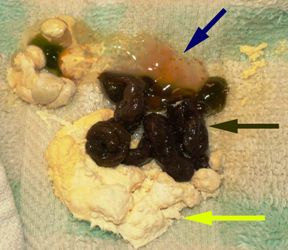Recognizing Abnormal Feces in Reptiles
It is very important to recognize what is normal and abnormal in the droppings of a reptile. If you see abnormal droppings, you shouId collect a sample and bring it to a veterinarian so it may be checked for parasites and other diseases. If you see that the feces is not formed but is instead soft or watery, place a small amount onto a damp paper towel and place it in a plastic bag. This should be brought to a veterinarian within 4 hrs and held at room temperature until then. If there is a large amount of mucus, you should include some of that along with the feces. On some occasions the urates may be dark yellow, orange, or even green or blue. If this is not the usual color for your reptile, collect some of the urates along with the feces. If you ever see drops of blood, the droppings have a very foul odor, or see undigested food in the feces of a snake or carnivorous lizard, a fecal parasite exam is essential.

Kingsnake Droppings. The yellow arrow points to urates, the part of the dropping that comes from the kidneys. The brown arrow points to feces, the part of the dropping that comes from the intestine. It is not unsual to find hair, feathers, and sometimes small pieces of bone in the feces of a snake or carnivorous lizard that is fed rodents or chicks. The blue arrow points to some mucus which can be normal in small amounts and may be found close to the urates or the feces. A small amount of urine may be found around the dropping and may appear as a wet spot in the paper, towel, or bedding.



